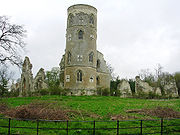
Wimpole's Folly
Encyclopedia

Folly
In architecture, a folly is a building constructed primarily for decoration, but either suggesting by its appearance some other purpose, or merely so extravagant that it transcends the normal range of garden ornaments or other class of building to which it belongs...
ruin located on the grounds of Wimpole Hall
Wimpole Hall
Wimpole Hall is a country house located within the Parish of Wimpole, Cambridgeshire, England, about 8½ miles southwest of Cambridge. The house, begun in 1640, and its 3,000 acres of parkland and farmland are owned by the National Trust and are regularly open to the public.Wimpole is...
, in the parish of Wimpole, in Cambridgeshire
Cambridgeshire
Cambridgeshire is a county in England, bordering Lincolnshire to the north, Norfolk to the northeast, Suffolk to the east, Essex and Hertfordshire to the south, and Bedfordshire and Northamptonshire to the west...
, England
England
England is a country that is part of the United Kingdom. It shares land borders with Scotland to the north and Wales to the west; the Irish Sea is to the north west, the Celtic Sea to the south west, with the North Sea to the east and the English Channel to the south separating it from continental...
.
The folly is designed to resemble the ruins of a medieval castle. It was built on the grounds of Wimpole Hall in the mid 1770s at the order of Philip Yorke, 1st Earl of Hardwicke
Philip Yorke, 1st Earl of Hardwicke
Philip Yorke, 1st Earl of Hardwicke PC was an English lawyer and politician who served as Lord Chancellor. He was a close confidant of the Duke of Newcastle, Prime Minister between 1754 and 1756 and 1757 until 1762....
, the then owner of Wimpole Hall
Wimpole Hall
Wimpole Hall is a country house located within the Parish of Wimpole, Cambridgeshire, England, about 8½ miles southwest of Cambridge. The house, begun in 1640, and its 3,000 acres of parkland and farmland are owned by the National Trust and are regularly open to the public.Wimpole is...
. The Earl of Hardwicke
Earl of Hardwicke
Earl of Hardwicke is a title in the Peerage of Great Britain. It was created in 1754 for Philip Yorke, 1st Baron Hardwicke, Lord Chancellor of Great Britain from 1737 to 1756. He had already been created Baron Hardwicke, of Hardwicke in the County of Gloucester, in 1733, and was made Viscount...
commissioned Sanderson Miller
Sanderson Miller
Sanderson Miller was a pioneer of Gothic revival architecture, and a landscape designer who often added follies or other Picturesque garden buildings and features to the grounds of an estate....
(the noted follies architect of the day) to design the folly in 1751, to then have it later built by Capability Brown
Capability Brown
Lancelot Brown , more commonly known as Capability Brown, was an English landscape architect. He is remembered as "the last of the great English eighteenth-century artists to be accorded his due", and "England's greatest gardener". He designed over 170 parks, many of which still endure...
in 1769.
The ruins are substantially built and stretch for two hundred feet in length, and include a four-storey Gothic
Gothic architecture
Gothic architecture is a style of architecture that flourished during the high and late medieval period. It evolved from Romanesque architecture and was succeeded by Renaissance architecture....
tower. They, and Wimpole Hall, are currently owned by the National Trust
National Trust for Places of Historic Interest or Natural Beauty
The National Trust for Places of Historic Interest or Natural Beauty, usually known as the National Trust, is a conservation organisation in England, Wales and Northern Ireland...
and open to the public.

